Asus Transformer Pad 300 Review

Key Features
- 10.1in IPS screen; 1280 x 800; 149ppi
- Tegra 3 quad-core 1.2GHz chip
- Android 4.0 (Ice Cream Sandwich)
- 15hrs battery life (with dock)
- Micro HDMI; USB 2.0; SD Card
- Price as Reviewed: £400
Introduction
Coming to write this review of the Asus Transformer Pad 300 it was hard to decide how to tackle it. Are we meant to look at it as a tablet? A netbook? Or as a whole new category completely.
As a tablet it will be going up against its stable mates: the original Transformer, the Transformer Prime as well as the plethora of other Android tablets available. It will of course be also judged alongside the iPad which is stiff competition to say the least.
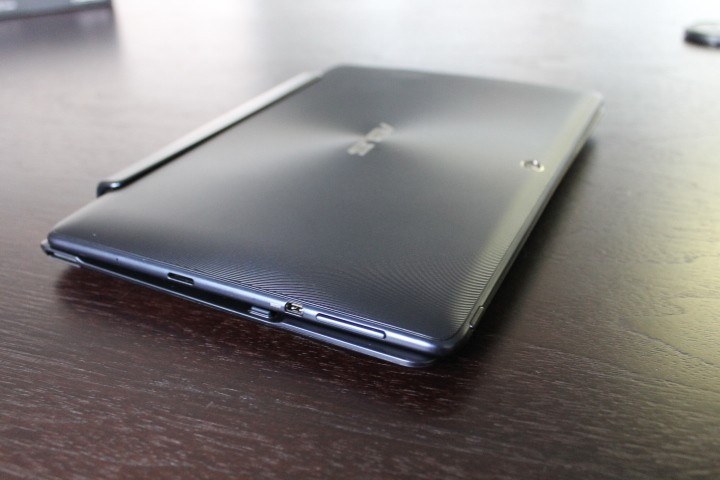
Looking it as a netbook, the competition is a lot less. The day of the netbook is effectively over, especially with the recent advent of the Ultrabook. While the Transformer Pad 300 runs Android rather than Windows, it can still provide a comparable typing experience for more productivity.
But to try and put the Transformer Pad 300 in either of these categories, would be doing it a disservice, as it combines some of the best aspects of both while retaining portability and value for money.
Transformer Pad 300: Design and Feel
For those who don't know, the Transformer line-up from Asus combines a regular Android tablet with a keyboard dock which not only provides a 'proper' tying experience, but adds an extra battery and more connectivity.
The Transformer Pad 300, which is the 'budget' version of the line-up compared to the slick and sleek Transformer Prime, is a little bit bulkier than its more expensive sibling, but is still fairly compact.
Looking at the tablet section, the Transformer Pad 300 features a 10.1in screen covered with Corning's scratch-resistant Gorilla Glass. Like most Android, tablets it has a 16:9 aspect ratio, unlike the 4:3 aspect ratio offered by the iPad. The tablet is 9.9mm thick and has a footprint of 262 x 181 mm.
The rear features the same textured back you find on a range of Asus products including the original Transformer and the Asus Zenbook laptop. This prevents fingerprints mucking up your shiny tablet as well as making it easier to grip.
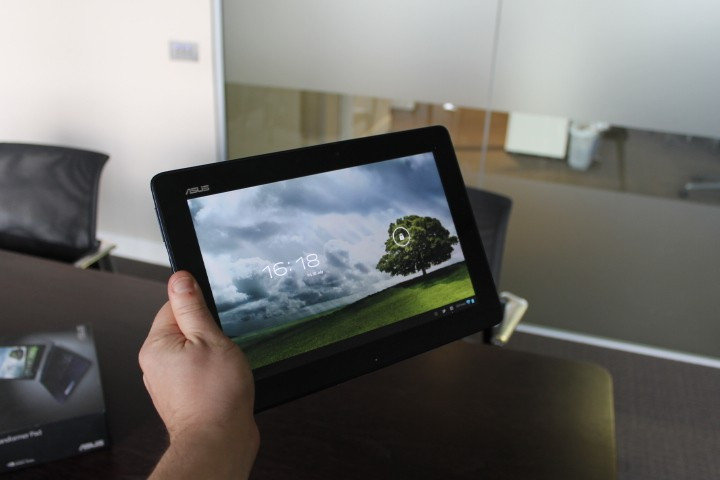
The tablet weighs 635g, which is less than the iPad (652g), and while it's not that heavy, we did find that holding it for extended periods of time got quite tiring, but there is of course always the option of popping it into the keyboard dock.
Speaking of which, the tablet slots into the dock using two clips on the bottom as well as connecting with Asus's proprietary data/power port. The keyboard dock itself is lightweight (546g) and features a plastic finish unlike the more premium metallic finish on the tablet.
Transformer Pad 300: Hardware and Connectivity
The tablet is powered by the Tegra 3 chip from Nvidia, which combines a quad-core processor with a 12-core GPU. However, it should be noted that the Transformer Pad 300's processor is clocked at 1.2GHz rather than the 1.3GHz processor on the Transformer Prime. This is backed up by 1GB of RAM.
You get an option of 16GB or 32GB of internal storage and there is also the options to extend the amount of storage you have via the full-sized SD card slot on the keyboard dock; up to an additional 32GB.
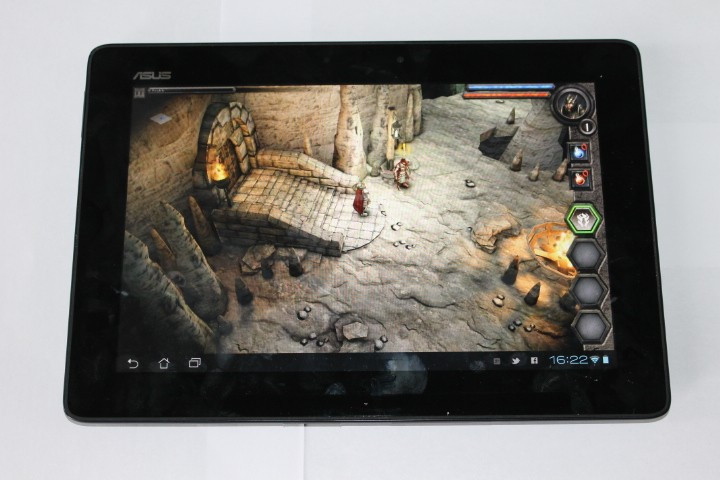
Connectivity on the tablet itself is poor. You get microHDMI to output HD video to your big-screen TV but no USB or microUSB. For data transfer and power, Asus has used a proprietary port on the bottom of the tablet, and you should also note that you have to use the charger Asus supplies in order to power up your tablet.
The lack of connectivity is overcome however when you slot the tablet into the dock. This gives you a full-sized USB port (something rarely seen on tablets) which is covered by a plastic flap, as well as the afore mentioned SD card reader.
Both these ports reside on the right-hand side of the dock, while the left-hand side is home to the data transfer/charging port.
Transformer Pad 300: Screen and Camera
The Transformer Prime features an ultrabright Super IPS+ display, and while the Transformer Pad 300 may not be as bright, it is still excellent. The IPS display features the same resolution of 1280 x 800 making everything seem sharp and clear.
IPS technology means that viewing angles are superb which we think is vital for using a tablet while on the move, when you can be sitting at a variety of angles. Watching HD video is fantastic with deep blacks and punchy, vibrant colours living easily side-by-side.
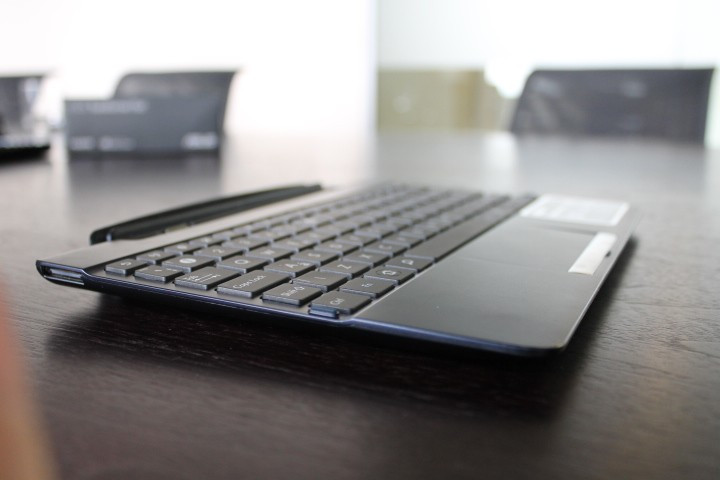
The brightness has been dialled down from 600nits on the Prime to 350nits here, but most of the time we didn't notice the difference. The only time you will miss it is when trying to view the screen in direct sunlight.
Rear cameras on tablets in general make little sense to us, and as such, it didn't matter that the 8 megapixel camera on the Transformer Pad 300 wasn't up to much. The camera will do if you are stuck, but the idea of using this on a regular basis does not make much sense to us.
The camera app lets you tweak a wide range of settings including exposure, ISO, white balance as well as choosing from a range of scene modes. Zoom is controlled by an on-screen slider as it the shutter button. Results bvary greatly with indoor images coming out poorly and low light use also lacking lots of details and clarity.
There is also a panorama mode and you can shoot 1080p video. A front-facing 1.2 megapixel camera is on-hand for video calling, which we would suggest is a lot more helpful.
Transformer Pad 300: Keyboard
One of the main reasons for buying the Transformer Pad 300 will be the keyboard dock that comes with it. While it also adds more battery and connectivity, it will be the 'real' typing experience which will attract most.
On-screen typing for most is not something you want to be doing on an extedned basis, and so the possibility of using a proper keyboard is appealling, especially for those looking to use a tablet for more than just content consumption.
The keyboard which comes with the Transformer Pad 300 is well-designed and comes with an integrated touchpad. When docked, the Transformer Pad is very reminiscent of a netbook from a few years ago but once you begin to use the keyboard, you begin to see the limitations of the set-up.
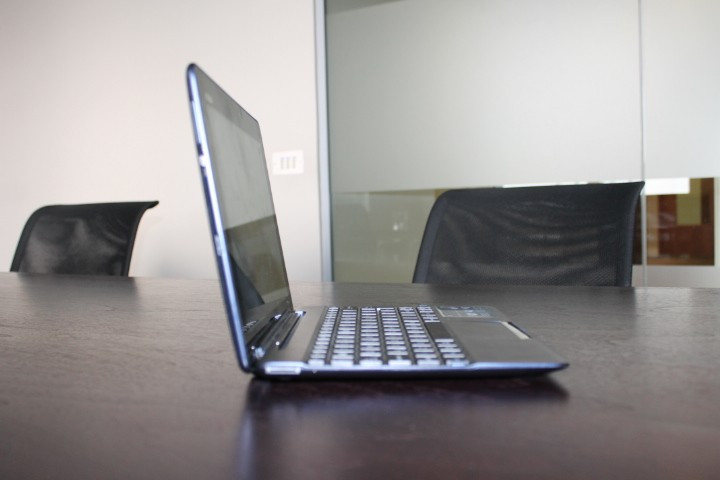
Due to the size of the keyboard, the keys are small and cramped. The layout has also been tweaked compared to a Windows layout, to provide some buttons to work with the Android interface, including a home key (instead of Windows key) and back key (instead of Esc).
However Android is a touch-interface and it simply doesn't work well with a keyboard, in a similar way to Windows 7 not working properly on a touch device.
The keyboard itself is very springy and feedback is poor. We tried to use it as our main laptop for a few days but it led to so much frustration and cursing, that we eventually had to give up and go back to using a laptop.
The convenience of being able to plug your tablet into a keyboard dock, built specifically for it, is great. But it is a solution only if you don't have access to a laptop and we defy anyone to say they enjoy working for any extended periods of time on this keyboard.
Transformer Pad 300: Performance and Battery Life
The combination of the Tegra 3 chip and Android 4.0 means that the tablet interface zips along very nicely and we didn't notice any slow down or lag when opening apps, or navigating the system.
Full HD video played back flawlessly, but you'll need to make sure you download a video player (such as DicePlayer) which takes advantage of hardware acceleration to get the best out of the Tegra 3 power.

In terms of gaming, the Transformer Pad 300 may not quite reach the heights of the latest iPad, but thanks to Nvidia's TegraZone, you will get a choice of games which have been optimised for this platform.
Playing the likes of ShadowGun and RipTide GP is a real pleasure and the combination of the IPS screen, powerful processor and 12-core GPU mean the Transformer Pad 300 is an excellent portable gaming device.
Battery life is one of the biggest selling points for the Transformer Pad 300. The tablet itself promises 10 hours of use with an extra five hours from the battery in the keyboard dock. In real life we found that Asus' promised figures were pretty much spot on, and with 15 hours combined battery life, there are few other tablets, let alone laptops, on the market which could promise that.
Transformer Pad 300: Verdict
As a tablet, the Transformer Pad 300 is one of the best on the market. Great screen, great battery life and powerful combination of Android 4.0 and Tegra 3. However at £400 it is an expensive option and for us, the third generation iPad at the same price, offers a better option.
As a netbook-replacement device, with the included keyboard dock, the Transformer Pad 300 offers excellent value. The combination of great tablet and the extra battery life and connectivity provided by the keyboard dock means the Transformer Pad 300 could be the answer to many people's dreams - and at £400 is a lot cheaper than many laptops.
However the typing experience is poor and can quickly become frustrating, meaning you may ditch the keyboard dock altogether. Therefore we would certainly recommend trying before buying.
Scores:
- Overall: 8/10
- Design: 9/10
- Screen: 9/10
- Keyboard: 7/10
- Connectivity: 8/10
- Value: 8/10
The Good:
- Great Battery
- Great Screen
- Proper typing experience
The Bad:
- Poor keyboard
- Expensive
© Copyright IBTimes 2025. All rights reserved.






















